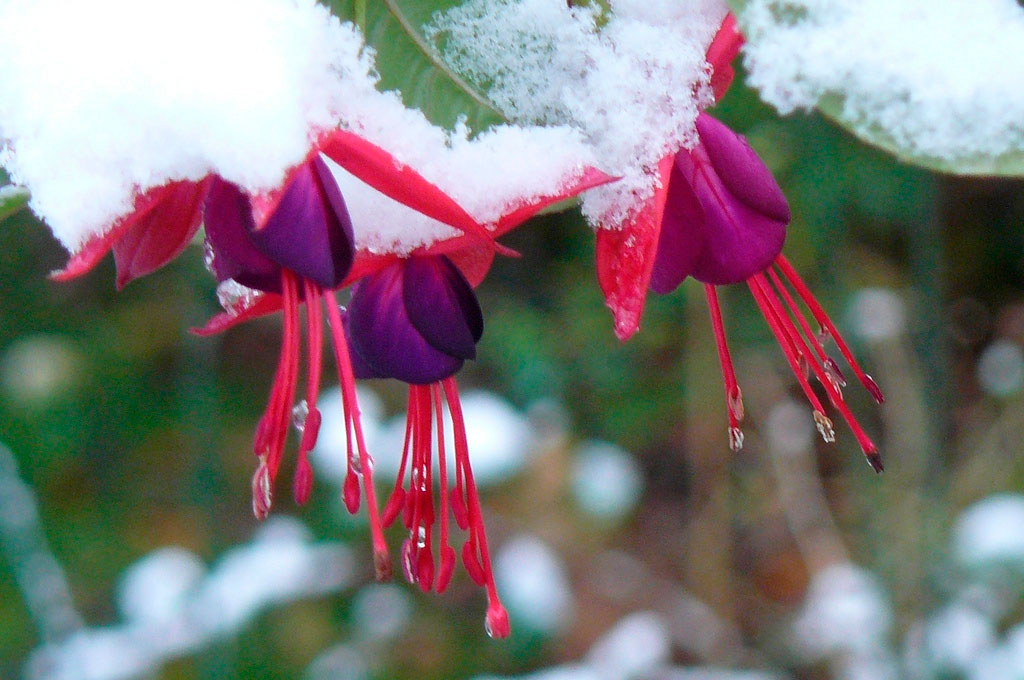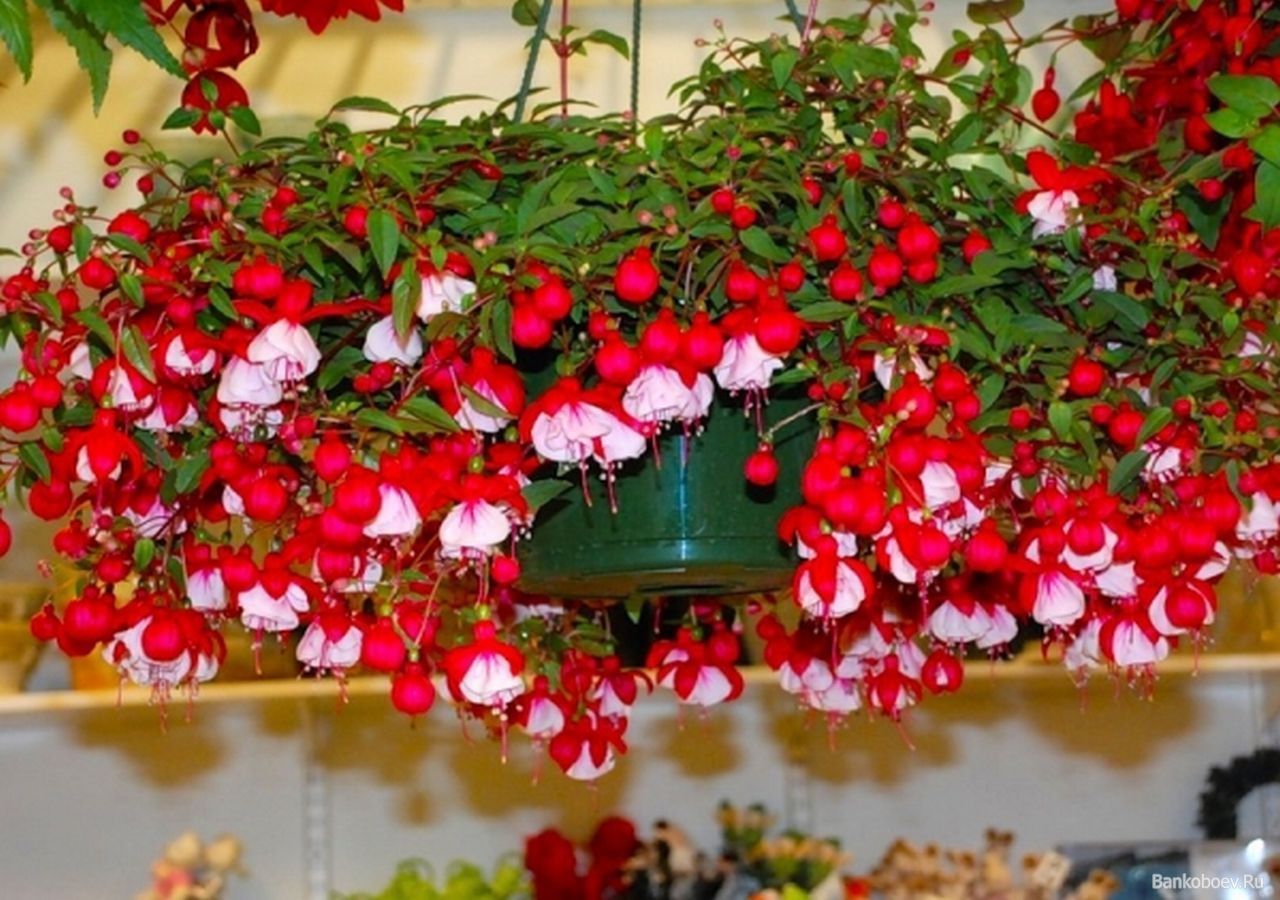 Those who are looking for unpretentious flower care with bright inflorescences should take a closer look at fuchsia. The plant is successfully grown both at home and outdoors. Fuchsia blooms most of the time with large gramophone flowers. Inflorescences attract the attention of everyone around with bright colors and definitely will not leave anyone indifferent. Growing a plant is quite simple and will not cause difficulties even for a beginner grower.
Those who are looking for unpretentious flower care with bright inflorescences should take a closer look at fuchsia. The plant is successfully grown both at home and outdoors. Fuchsia blooms most of the time with large gramophone flowers. Inflorescences attract the attention of everyone around with bright colors and definitely will not leave anyone indifferent. Growing a plant is quite simple and will not cause difficulties even for a beginner grower.
Content
How to choose the right seedlings in the store
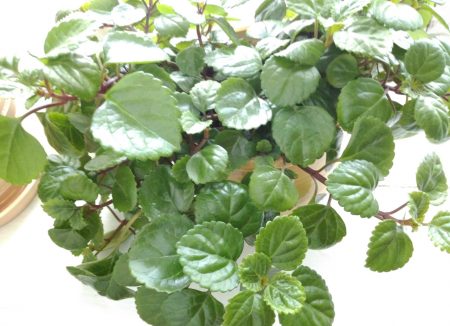 Before you buy a plant, it is very important to pay attention to its condition. Healthy fuchsia has a well-leafy crown with dull green leaves. It is better to buy a plant during budding or during rest. Blooming fuchsia will not last long, taking root in a new place, it can lose inflorescences.
Before you buy a plant, it is very important to pay attention to its condition. Healthy fuchsia has a well-leafy crown with dull green leaves. It is better to buy a plant during budding or during rest. Blooming fuchsia will not last long, taking root in a new place, it can lose inflorescences.
When buying seedlings, carefully study the root system. The roots of white color, without plaque and traces of the fungus are considered suitable for planting. If the root system has already managed to grow, then immediately on the day of planting it is cut to 10 centimeters.
Landing
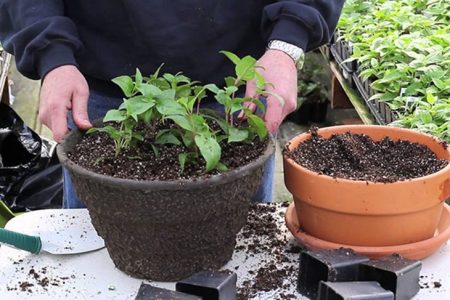 When grown in open ground, seedlings are transplanted in the warm season. It may be the end of spring, the earth is already warming well by this time, so frost is not terrible. Before planting, the seedlings are soaked in a solution of potassium permanganate for an hour, and then planted in a soil mixture. Fuchsia pretty quickly gets used to the new territory and is actively starting to develop.
When grown in open ground, seedlings are transplanted in the warm season. It may be the end of spring, the earth is already warming well by this time, so frost is not terrible. Before planting, the seedlings are soaked in a solution of potassium permanganate for an hour, and then planted in a soil mixture. Fuchsia pretty quickly gets used to the new territory and is actively starting to develop.
For active root formation, the roots of the flower are immersed in an aqueous solution of Kornevin for a couple of hours.
Fuchsia easily grows in porous, non-acidified soil. When planting, you can add a bucket of peat and humus to 1 square meter of land. They carefully dig the soil, make a hole in it and lower the roots of the flower. They fill it with earth, and then pour it with warm water.
Care
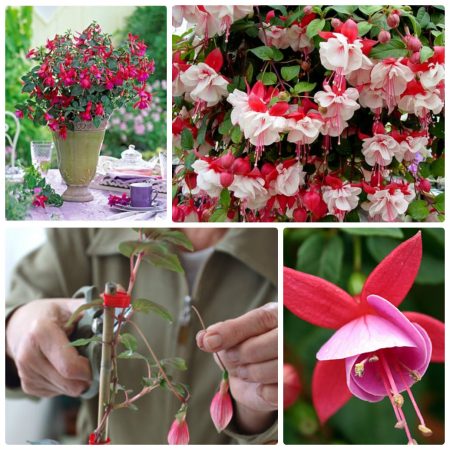 In order for fuchsia to actively bloom every spring and summer, it must be properly looked after. Care consists in properly watering and maintaining humidity, as well as in determining the correct location and temperature.
In order for fuchsia to actively bloom every spring and summer, it must be properly looked after. Care consists in properly watering and maintaining humidity, as well as in determining the correct location and temperature.
Location
Being a thermophilic plant, fuchsia loves diffused sunlight. A home flower can be placed on a window on the east side of the house, but in such a way that direct sunlight does not fall on it. When growing outdoors, the plant is planted on a flat, well-lit area, can be planted in light partial shade of trees. Strong shaded terrain is not suitable for cultivation. Lack of sun is the cause of weak budding and a decrease in the color intensity of inflorescences and leaves.
Temperature
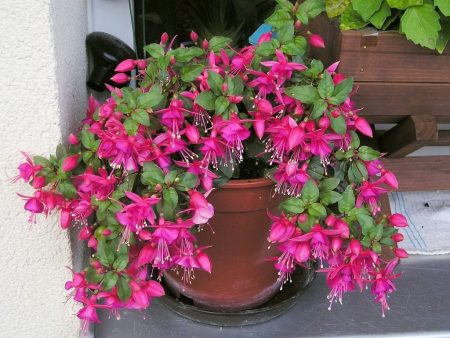 Flowering occurs from mid-May and ends in autumn. During flowering, you need to provide a temperature in the range from 20 to 25 degrees heat. This interval is considered the most favorable for the formation of inflorescences. When the dormancy period begins (mid-October, November), the flower can be rearranged in a cool room with a temperature of 20-22 degrees Celsius.
Flowering occurs from mid-May and ends in autumn. During flowering, you need to provide a temperature in the range from 20 to 25 degrees heat. This interval is considered the most favorable for the formation of inflorescences. When the dormancy period begins (mid-October, November), the flower can be rearranged in a cool room with a temperature of 20-22 degrees Celsius.
Watering
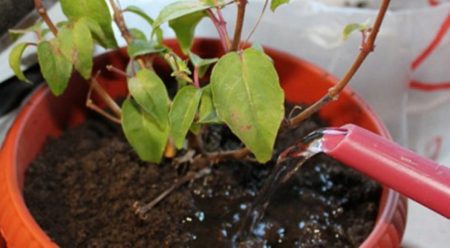 Water the flower at least 1 time per week, when it blooms, and after flowering, they switch to infrequent watering 2 times a month. In hot weather, the frequency can be increased to once every 3-4 days. For irrigation use cool, settled water.Fuchsia reacts sharply to a lack of moisture in the ground, it can start dropping buds and leaves with a lack of water.
Water the flower at least 1 time per week, when it blooms, and after flowering, they switch to infrequent watering 2 times a month. In hot weather, the frequency can be increased to once every 3-4 days. For irrigation use cool, settled water.Fuchsia reacts sharply to a lack of moisture in the ground, it can start dropping buds and leaves with a lack of water.
Humidity and spraying the flower
In the summer, especially on hot days, the leaves and trunk can be irrigated with clean water from a spray bottle, but in this case, moisture should not fall on the buds. To increase and maintain humidity at the level of 60-80%, special devices are sometimes used - humidifiers. Thus, favorable conditions are created for fuchsia, in which it begins to bloom profusely.
Transfer
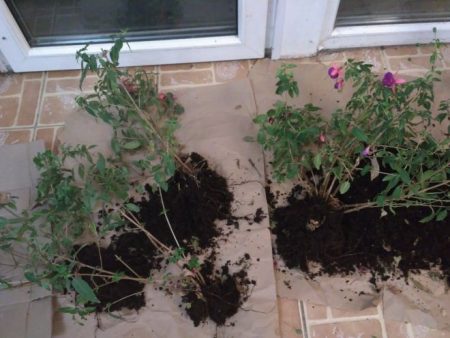 Fuchsia is able to live for 8-10 years, however, in older representatives (aged 5 years and older), flowering occurs less and less with time. To avoid such an outcome, it is recommended to transplant the plant to a new place. A change of scenery activates flowering and contributes to its duration. The transplant is carried out approximately once every 4-5 years. For indoor flowers, a larger diameter pot is used so that there is enough space for the development of the root system.
Fuchsia is able to live for 8-10 years, however, in older representatives (aged 5 years and older), flowering occurs less and less with time. To avoid such an outcome, it is recommended to transplant the plant to a new place. A change of scenery activates flowering and contributes to its duration. The transplant is carried out approximately once every 4-5 years. For indoor flowers, a larger diameter pot is used so that there is enough space for the development of the root system.
Top dressing
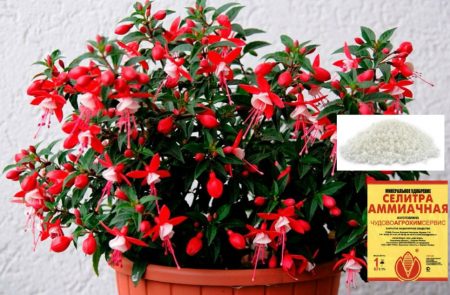 Top dressing is carried out when the need really arises in it. This may be a sudden yellowing of even new leaves or a sluggish growth of shoots, a long absence of flowering. When planting young seedlings, fertilizers begin to be used 2 weeks after planting. For the rapid development of the root system and a set of deciduous masses, nitrogen fertilizers are used - ammonium nitrate or urea. This or that drug is bred in 10 liters of water and watered under a bush. You can repeat the feeding after 2 weeks.
Top dressing is carried out when the need really arises in it. This may be a sudden yellowing of even new leaves or a sluggish growth of shoots, a long absence of flowering. When planting young seedlings, fertilizers begin to be used 2 weeks after planting. For the rapid development of the root system and a set of deciduous masses, nitrogen fertilizers are used - ammonium nitrate or urea. This or that drug is bred in 10 liters of water and watered under a bush. You can repeat the feeding after 2 weeks.
To bookmark the budding phase in indoor and outdoor flowers, potassium sulfate is fed. A teaspoon of powder is dissolved in 5 liters of water and watered under the root. For the entire flowering time, no more than 2-3 dressings are required.
Pruning and pinching
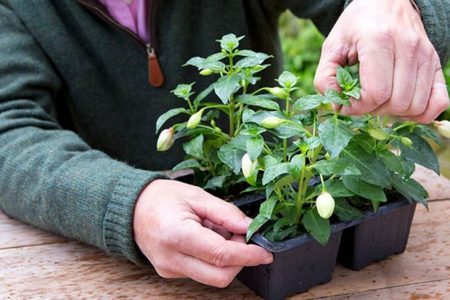 Especially important for the flower is timely pruning of shoots. The procedure is carried out when fuchsia is at rest - before flowering and after it. Lateral shoots are removed completely, young branches are significantly shortened by ½ length. Cut points must be treated with a pink solution of potassium permanganate or hydrogen peroxide. Pinch the crown of the main stalk. Thus, a beautiful bush with a spreading crown is formed. Its formation can take up to 2-3 years.
Especially important for the flower is timely pruning of shoots. The procedure is carried out when fuchsia is at rest - before flowering and after it. Lateral shoots are removed completely, young branches are significantly shortened by ½ length. Cut points must be treated with a pink solution of potassium permanganate or hydrogen peroxide. Pinch the crown of the main stalk. Thus, a beautiful bush with a spreading crown is formed. Its formation can take up to 2-3 years.
Pruning is useful for fuchsia and is a procedure that results in a plant rejuvenating and gaining strength. Fuchsia quite easily tolerates the removal of excess shoots, is not stressed, and its growth after proper pinching is noticeably accelerated.
Pruning is done with clippers or a sharp knife.
Winter Care
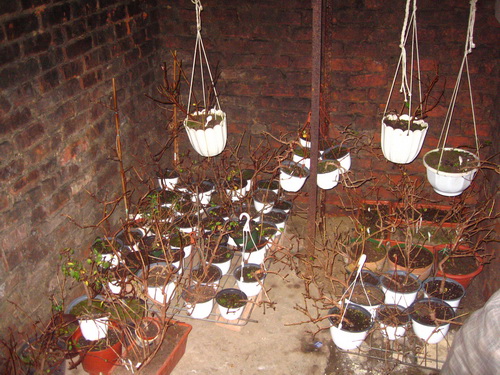 When grown outdoors for the winter in a temperate climate, the plants either dig up or mulch the soil near the planted flowers with straw or peat, and cover with agrofibre from above. Fuchsia is considered a flower that can withstand small frosts, however, it does not tolerate sharp temperature extremes.
When grown outdoors for the winter in a temperate climate, the plants either dig up or mulch the soil near the planted flowers with straw or peat, and cover with agrofibre from above. Fuchsia is considered a flower that can withstand small frosts, however, it does not tolerate sharp temperature extremes.
After wintering, when the snow melts, and the air temperature rises to plus 15 degrees, the shelter is removed. When dry and frozen shoots appear on the bushes during the winter, they are cut off. After some time, leaves form on fuchsia, and soon buds will appear.
Breeding
The flower multiplies well, young shoots perfectly take root in the new soil and instantly gain color. Methods of reproduction are different: cuttings, leaves and seeds.
Propagation by cuttings
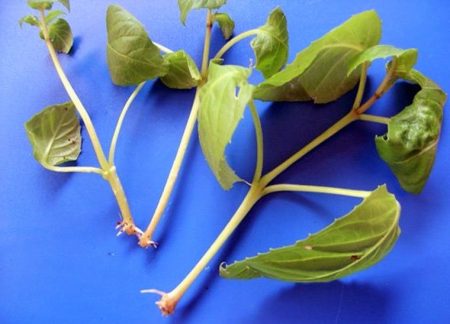 The most common method of reproduction is actively used by flower growers to create large flower gardens. In autumn, after flowering, an adult bush 2-3 years old is dug out of the ground. The rhizome is cleaned of soil, soaked for a couple of hours in water. New young shoots with roots are separated from the mother bush.The shoot is placed in the water for several days until it takes root, and then transplanted into a pot. You can first grow the plant in a peat tablet, and then, when it is sufficiently strong, transplant into a soil mixture.
The most common method of reproduction is actively used by flower growers to create large flower gardens. In autumn, after flowering, an adult bush 2-3 years old is dug out of the ground. The rhizome is cleaned of soil, soaked for a couple of hours in water. New young shoots with roots are separated from the mother bush.The shoot is placed in the water for several days until it takes root, and then transplanted into a pot. You can first grow the plant in a peat tablet, and then, when it is sufficiently strong, transplant into a soil mixture.
Autumn harvest of cuttings
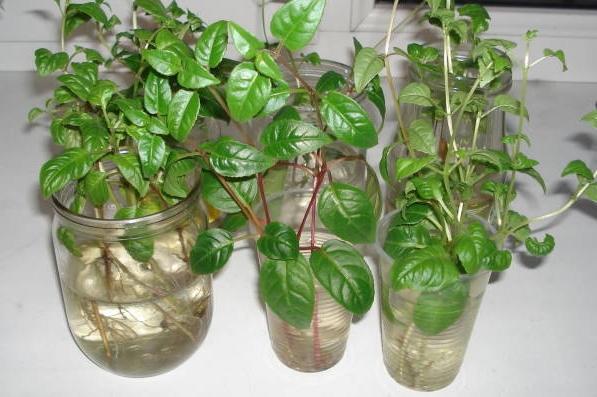 The method is used to preserve seedlings in the winter. Then, after wintering, the plants are transplanted into the open ground. Separate from the main bush cuttings with a length of 15-20 centimeters and plant it immediately in fertile soil. Store the seedling in the basement or cellar. With the advent of spring, the stalk is taken out and put in water to release the roots. After 2-3 weeks, he will be ready to land on the street.
The method is used to preserve seedlings in the winter. Then, after wintering, the plants are transplanted into the open ground. Separate from the main bush cuttings with a length of 15-20 centimeters and plant it immediately in fertile soil. Store the seedling in the basement or cellar. With the advent of spring, the stalk is taken out and put in water to release the roots. After 2-3 weeks, he will be ready to land on the street.
Leaf propagation
Rooting of the leaf does not take long and allows you to get an independent plant in the shortest possible time. A young and healthy leaf is cut from the flower and put in a container of water. After a few weeks, the leaf gives root. Once they reach a length of 5 centimeters, the leaf can be transplanted into a pot of earth and grown as a separate flower.
Seed propagation
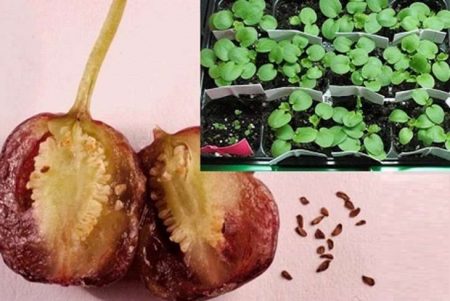 The method is quite rare, since seed germination is low. Planting material is sold in large flower shops and garden products. The main advantage is its cheapness. It takes more than one year to grow seeds. Seeds are pre-soaked in a growth stimulator for a couple of hours. Soaked grains are washed under water and planted in soil containing sand and peat. Cover the container with glass or plastic wrap and wait for seedlings. After 10-14 days, young plants appear on the surface of the earth, which in 2 weeks will be ready to dive. In open ground, seedlings can be planted when its growth reaches 10-15 centimeters.
The method is quite rare, since seed germination is low. Planting material is sold in large flower shops and garden products. The main advantage is its cheapness. It takes more than one year to grow seeds. Seeds are pre-soaked in a growth stimulator for a couple of hours. Soaked grains are washed under water and planted in soil containing sand and peat. Cover the container with glass or plastic wrap and wait for seedlings. After 10-14 days, young plants appear on the surface of the earth, which in 2 weeks will be ready to dive. In open ground, seedlings can be planted when its growth reaches 10-15 centimeters.
Disease
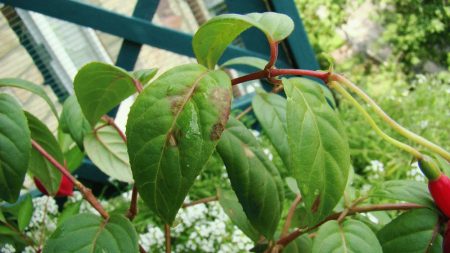 Of the most common diseases, rot has to be experienced. It occurs during improper irrigation and an excess of moisture in the soil. Excessive moisture in the leaves, especially in the evening, provokes the onset of the disease. As a result of infection, a white coating appears on the leaves, and they themselves begin to fade over time. Gradually, the bush and the ground are completely affected by rot.
Of the most common diseases, rot has to be experienced. It occurs during improper irrigation and an excess of moisture in the soil. Excessive moisture in the leaves, especially in the evening, provokes the onset of the disease. As a result of infection, a white coating appears on the leaves, and they themselves begin to fade over time. Gradually, the bush and the ground are completely affected by rot.
To avoid infection, when planting the land must be calcined at high temperature (80-90 degrees) and treated with 2% solution of copper sulfate. After planting flowers, preventive treatment is carried out in the middle and late spring: Bordeaux fluid is used to water the soil and irrigate the shoots. Repeat the procedure after 2 weeks.
If the infection does happen, the infected shoots or leaves are immediately cut off from the healthy part. The plant is dug out of the ground, the condition of the roots is assessed. If white plaque is present on them, diseased roots are cut off, soaked in diluted Fitosporin solution for an hour and transplanted into healthy, pre-treated soil.
Pests and how to deal with them
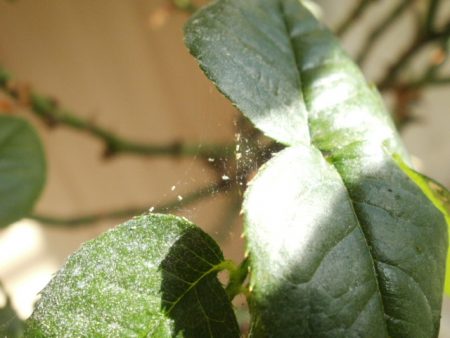 When grown indoors, pests are rare. It can be a black midge from an excess of moisture. A sure remedy for midges is considered the infusion of onion peels. Husk from 3-4 bulbs is poured into 2 liters of water and insisted for 3 days. Then the mixture is filtered and irrigated with a flower. The cat cannot stand the onion smell and will disappear.
When grown indoors, pests are rare. It can be a black midge from an excess of moisture. A sure remedy for midges is considered the infusion of onion peels. Husk from 3-4 bulbs is poured into 2 liters of water and insisted for 3 days. Then the mixture is filtered and irrigated with a flower. The cat cannot stand the onion smell and will disappear.
If fuchsia is grown on a garden plot, the chances of infection increase at times. A flower can become an object for attack by spiders, caterpillars, nematodes, whiteflies and ticks. From insects help special drugs - insecticides. They are detrimental to pests. The insecticide is diluted in a predetermined proportion, which the manufacturer indicates on the packaging for the drug.
When using insecticides, gloves should be used. The substance may contain poisons and may cause an allergic reaction in contact with skin and mucous membranes.
Of the popular methods of repelling insects, a mixture of laundry soap with boric acid works well. On a bucket of water take 40-50 grams of grated soap and a tablespoon of boric acid.The mixture is applied to the leaves and stem in the morning. Repeat the procedure after 2 weeks. The optimal time for processing is mid and late spring.
Fuchsia is perfect for ennoblement of a personal or summer cottage territory. At the same time, the flower looks good on the windowsill of the house. Its bright appearance and abundant flowering will please you for a long time from year to year, and care for the flower will not take much time and effort.

